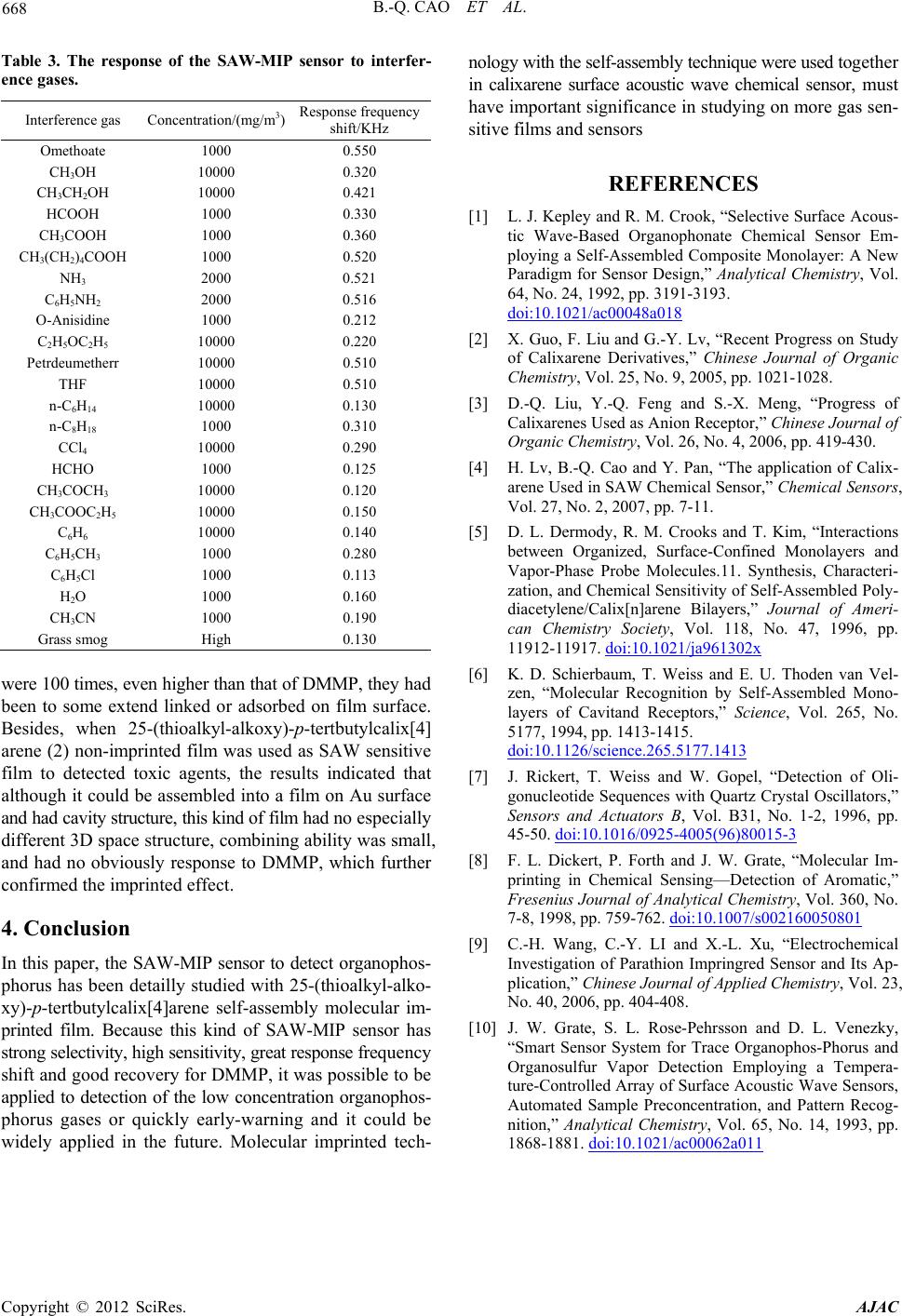
B.-Q. CAO ET AL.
Copyright © 2012 SciRes. AJAC
668
Table 3. The response of the SAW-MIP sensor to interfer-
ence gases.
Interference gas Concentration/(mg/m3) Response frequency
shift/KHz
Omethoate 1000 0.550
CH3OH 10000 0.320
CH3CH2OH 10000 0.421
HCOOH 1000 0.330
CH3COOH 1000 0.360
CH3(CH2)4COOH 1000 0.520
NH3 2000 0.521
C6H5NH2 2000 0.516
O-Anisidine 1000 0.212
C2H5OC2H5 10000 0.220
Petrdeumetherr 10000 0.510
THF 10000 0.510
n-C6H14 10000 0.130
n-C8H18 1000 0.310
CCl4 10000 0.290
HCHO 1000 0.125
CH3COCH3 10000 0.120
CH3COOC2H5 10000 0.150
C6H6 10000 0.140
C6H5CH3 1000 0.280
C6H5Cl 1000 0.113
H2O 1000 0.160
CH3CN 1000 0.190
Grass smog High 0.130
were 100 times, even higher than that of DMMP, they had
been to some extend linked or adsorbed on film surface.
Besides, when 25-(thioalkyl-alkoxy)-p-tertbutylcalix[4]
arene (2) non-imprinted film was used as SAW sensitive
film to detected toxic agents, the results indicated that
although it could be assembled into a film on Au surface
and had cavity structure, this kind of film had no especially
different 3D space structure, combining ability was small,
and had no obviously response to DMMP, which further
confirmed the imprinted effect.
4. Conclusion
In this paper, the SAW-MIP sensor to detect organophos-
phorus has been detailly studied with 25-(thioalkyl-alko-
xy)-p-tertbutylcalix[4]arene self-assembly molecular im-
printed film. Because this kind of SAW-MIP sensor has
strong selectivity, high sensitivity, great response frequency
shift and good recovery for DMMP, it was possible to be
applied to detection of the low concentration organophos-
phorus gases or quickly early-warning and it could be
widely applied in the future. Molecular imprinted tech-
nology with the self-assembly technique were used together
in calixarene surface acoustic wave chemical sensor, must
have important significance in studying on more gas sen-
sitive films and sensors
REFERENCES
[1] L. J. Kepley and R. M. Crook, “Selective Surface Acous-
tic Wave-Based Organophonate Chemical Sensor Em-
ploying a Self-Assembled Composite Monolayer: A New
Paradigm for Sensor Design,” Analytical Chemistry, Vol.
64, No. 24, 1992, pp. 3191-3193.
doi:10.1021/ac00048a018
[2] X. Guo, F. Liu and G.-Y. Lv, “Recent Progress on Study
of Calixarene Derivatives,” Chinese Journal of Organic
Chemistry, Vol. 25, No. 9, 2005, pp. 1021-1028.
[3] D.-Q. Liu, Y.-Q. Feng and S.-X. Meng, “Progress of
Calixarenes Used as Anion Receptor,” Chinese Journal of
Organic Chemistry, Vol. 26, No. 4, 2006, pp. 419-430.
[4] H. Lv, B.-Q. Cao and Y. Pan, “The application of Calix-
arene Used in SAW Chemical Sensor,” Chemical Sensors,
Vol. 27, No. 2, 2007, pp. 7-11.
[5] D. L. Dermody, R. M. Crooks and T. Kim, “Interactions
between Organized, Surface-Confined Monolayers and
Vapor-Phase Probe Molecules.11. Synthesis, Characteri-
zation, and Chemical Sensitivity of Self-Assembled Poly-
diacetylene/Calix[n]arene Bilayers,” Journal of Ameri-
can Chemistry Society, Vol. 118, No. 47, 1996, pp.
11912-11917. doi:10.1021/ja961302x
[6] K. D. Schierbaum, T. Weiss and E. U. Thoden van Vel-
zen, “Molecular Recognition by Self-Assembled Mono-
layers of Cavitand Receptors,” Science, Vol. 265, No.
5177, 1994, pp. 1413-1415.
doi:10.1126/science.265.5177.1413
[7] J. Rickert, T. Weiss and W. Gopel, “Detection of Oli-
gonucleotide Sequences with Quartz Crystal Oscillators,”
Sensors and Actuators B, Vol. B31, No. 1-2, 1996, pp.
45-50. doi:10.1016/0925-4005(96)80015-3
[8] F. L. Dickert, P. Forth and J. W. Grate, “Molecular Im-
printing in Chemical Sensing—Detection of Aromatic,”
Fresenius Journal of Analytical Chemistry, Vol. 360, No.
7-8, 1998, pp. 759-762. doi:10.1007/s002160050801
[9] C.-H. Wang, C.-Y. LI and X.-L. Xu, “Electrochemical
Investigation of Parathion Impringred Sensor and Its Ap-
plication,” Chinese Journal of Applied Chemistry, Vol. 23,
No. 40, 2006, pp. 404-408.
[10] J. W. Grate, S. L. Rose-Pehrsson and D. L. Venezky,
“Smart Sensor System for Trace Organophos-Phorus and
Organosulfur Vapor Detection Employing a Tempera-
ture-Controlled Array of Surface Acoustic Wave Sensors,
Automated Sample Preconcentration, and Pattern Recog-
nition,” Analytical Chemistry, Vol. 65, No. 14, 1993, pp.
1868-1881. doi:10.1021/ac00062a011